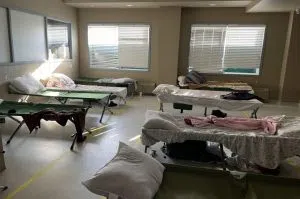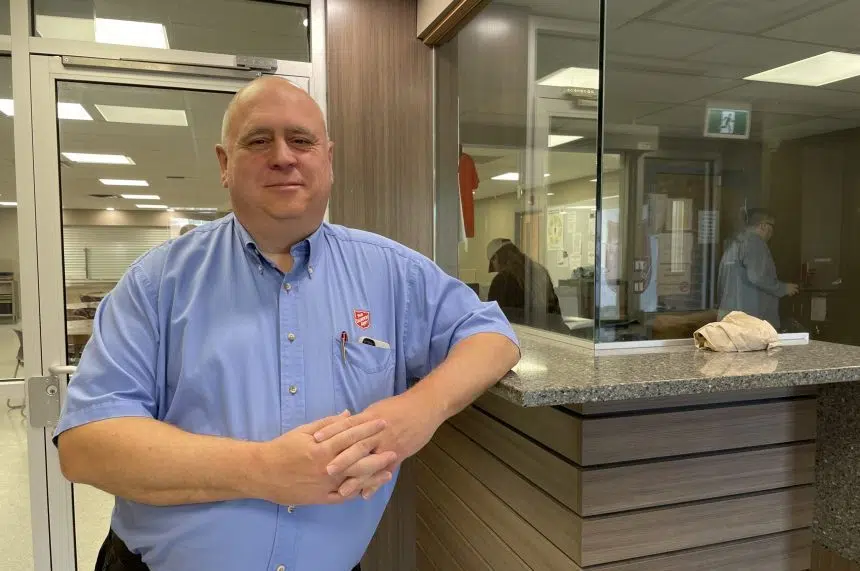Ever since Gordon Taylor started working for the Salvation Army, he’s always been concerned heading into the winter season.
Having more people out on the streets only heightens that concern, he said. A recent study in Saskatoon estimated there are about 550 homeless people in the city.
“I’m working in a place where we can actually see we’ve helped someone each day,” said Taylor, the executive director at Crossroads Residential Services in Saskatoon.
He said his work makes him truly appreciate his own bed.
The Salvation Army men’s shelter has 75 shelter beds, and 25 beds designated for their halfway house. Thirty of the shelter beds are cots set up in the multipurpose and dining areas overnight.
Those 30 beds were added to accommodate the closure of the Lighthouse Supported Living, after that shelter lost its provincial funding.
Taylor said the funding for those beds and the additional work they came with — more staff, extra cleaning duties and more mouths to feed — shifted to the Salvation Army from the Lighthouse when they received the beds.
But even with those additional spaces available, Taylor said he’s still not sure there will be enough shelter beds for the winter in Saskatoon.
Last year, when other shelters in the city were filled on cold nights, Taylor said Crossroads was able to bring a few extra people into their space to stay warm.
“We won’t be able to do that as much as we did last winter,” Taylor said, explaining that the new beds now take up that extra space.
Taylor said he’s always concerned as the weather begins to change. The issue, he said, is not simply one of having enough beds ready, as unexpected problems can sometimes arise.
Taylor moved to Saskatoon in July, but last winter he was working in Winnipeg with the Salvation Army. He said one of the shelters in that city, similar in size to the Salvation Army’s shelter, had to shut down unexpectedly because of plumbing issues.
“That’s the type of thing that you can’t know it’s going to happen, but you have to be prepared for it,” he said.

Extra beds set up in the multipurpose area at the Salvation Army Crossroads Residential Services in Saskatoon on Oct. 18, 2022. (Libby Giesbrecht/650 CKOM)
No matter where he works, Taylor said the same conversation about getting ready for the cold weather comes up every year. He said he’s been part of meetings with Mayor Charlie Clark and his staff, as well as group meetings with city representatives and other agencies, to put together a plan for this winter in Saskatoon.
“Things are being worked on to make sure we’re ready, but if you asked if we’re ready tonight, if it was minus 40 (degrees), we probably aren’t yet. But we’re getting there,” he said.
Taylor said his organization has to focus on the needs of its own shelter and serving the people that rely on it. The new influx of beds means they don’t have capacity to do much more beyond that.
Crossroads operates much like the Saskatoon Tribal Council’s Wellness Centre, where clients are allowed to keep a room for a set period of time. The shelters also provide meals and other support services to those staying there.
Tribal Council Chief Mark Arcand said he’s not feeling calm heading into the colder weather this year.
“I’m nervous,” Arcand said. “The numbers are growing rapidly.”
He said the wellness centre has been filled to capacity ever since it first opened last year.
“It’s getting bad in our city, and it has to be addressed sooner or later with more opportunities to help as many homeless people as we can,” Arcand said.
“Man, I wish I could open my door to more. I just don’t have the room right now.”
Just a week ago, Arcand’s staff reported about 30 people waiting outside the full-to-capacity shelter at night.
The tribal council’s shelter offers just over 100 beds.
“If we’re only doing 100, somebody else is doing 100, we’re only at half (of the homeless population), I’ll say,” Arcand said.
Families, people struggling with addictions, and those suffering from mental health challenges are among those who seek help at the Wellness Center, Arcand said, which operates on a first-come, first-served basis, with a number of stringent rules intended to keep the residents at the centre safe.
“If we don’t have structure, it’s going to really create a lot of chaos and people will get hurt,” said Arcand, who enforces a policy of zero tolerance for violence.
Anyone who can’t follow the rules loses their place at the shelter for a time.
Last week, Arcand said, the facility housed five families, including one with a three-month-old child. Single mothers stay at the centre with their kids while trying to maintain schedules that balance child care and going to school.
“When you see parents like that, who are trying to have it better for themselves and their family, you have to really support this initiative and say, ‘How do we make it better?'” Arcand said.
“They want to succeed. That’s why they’re going to school.”
As the weather gets colder, those who don’t manage to secure a spot at the Wellness Centre or the Salvation Army at night will resort to trying to stay warm at any space they can find, Arcand said.
He called those situations unacceptable.
“We’ve got to provide some humanity, and we’ve got to think of some bigger solutions,” he said.
Arcand said he’s planning to open a permanent shelter in the coming months, but he wants to see better communication and collaboration from the City and other stakeholders when it comes to addressing the homeless concerns in Saskatoon.
The chief said he wants people to understand that the problem of homelessness is a community issue, caused by a variety of factors including the rising costs of food and other necessities.
Arcand says the biggest thing people can offer right now is understanding and empathy.
Taylor said the Salvation Army is accepting donations of coats and other warm clothing items throughout the winter months. Crossroads is also always looking for more staff, which Taylor said is one of its greatest challenges.











